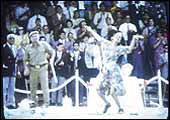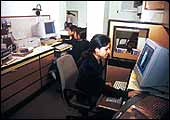 |
 |

|
Ericsson
Brand: Ericsson Campaign: ''Join me for dinner tonight''
Agency: Enterprise Nexus
Subtle humour and subdued sensuality in product-oriented advertising
|
Cadbury India
Brand: Cadbury Dairy Milk
Campaign: Kya Swaad Hai Zindagi Mein
Agency: O&M An out-and-out slice-of-life commercial,
necessitated by Cadbury's need to extend the product to adults |
Channel V
Brand: Channel V
Campaign: Quick Gun Murugan Agency: In-house
Told the world and even reminded us that 'we are like this only'
|
|
|
|
|
Air India
Brand: Air-India
Campaign: Air-India Maharaja
Agency: HTA
The mascot created by Bobby Kooka that not only reflected the
mood of the nation and its glorious history, but did better
than the brand itself |
Raymond
Brand: Raymond Fabrics
Campaign: The Complete Man
Agency: Enterprise Nexus
Elevated the brand to a 'way of life', taking aspirational advertising
to a new high |
Gujarat Co-op Milk Marketing Federation
Brand: Amul Butter
Campaign: Outdoor
Agency: DaCunha Assoc.
An eternal take on what is topical, with a twist that has become
the brand's signature |
|
|
|
|
Bajaj Auto
Brand: Bajaj
Campaign: Hamara Bajaj
Agency: Lintas
Reflected the mood of the nation, taking pride in our own identity,
and had a memorable tune |
Titan Industries
Brand: Titan watches
Campaign: Gifting
Agency: O&M
Perhaps the only commercial in Indian advertising to have made
music-Mozart's 25th symphony-a brand signature P.S: Music by
A.R. Rahman |
Hindustan Lever
Brand: Surf
Campaign: Lalitaji
Agency: Lintas
A perfect personification of the middle-class, value-seeking
Indian consumer, Lalitaji was an ad persona who found instant
empathy |
|
|
|
|
Mirc Electronics
Brand: Onida
Campaign: Onida Devil
Agency: Advertising Avenues
Perhaps the only brand in India to have used a negative emotion,
envy, to its advantage by the end of the campaign, though, the
devil had been overused |
Tisco
Brand: Tata Steel
Campaign: We also make steel
Agency: HTA
The larger than life imagery of corporate philantrophy; what
it means to be a good corporate citizen |
Hindustan Lever
Brand: Liril
Campaign: The girl under the waterfall
Agency: Lintas
The ad that said no to bathrooms, brought in a fresh breath
of life into an otherwise boring product category |
 |
| Indian advertising: towards accountability |
The Coming Of Age Of Indian Advertising
Structurally speaking,
the Indian advertising industry is up there with the best in the
world. Every major international advertising name, from WPP, to
the Interpublic Group, to Grey, to Omnicom, to Publicis has a presence
in the country, often through a marquee Indian agency in which it
has a majority stake. Much of this internationalisation has happened
in the nineties. Subsequently advertising agencies have also transformed
themselves into 'marketing communications' specialists with a finger
in media buying, public relations, direct marketing, design, events,
and the like. Advertising is still the largest piece of the pie,
but as the economic engine sputters marketers are discovering the
benefits of below the line activities like merchandising and sales
promotions.
INDIA'S
TOP ADVERTISING AGENCIES
|
Hindustan Thompson Associates
Ogilvy & Mather
Mudra Communications
FCB-ULKA Advertising
Rediffusion DY&R
McCann-Erickson India
R.K.Swamy/BBDO Advertising
Trikaya Grey Advertising
Chaitra Leo-Burnett
Pressman Advertising & Marketing |
1,077
742
522
521
442
347
256
220
197
187
|
However, the Indian
advertising industry will really have come of age when it starts
understanding the consumer. That process has already started with
the 'creative function' of advertising coming out of what some call
the ''clutches of the South-Mumbai social class''. Agencies themselves
are hastening this process by investing in research aimed at understanding
why we behave the way we do (upstream consumer research) as opposed
to downstream market research (how we behave). Next step: measuring
the effectiveness of advertising and challenging the commission-based
revenue model. Accountability, here we come!
-Shailesh Dobhal
Studying Eyeballs: Online
Behaviour
With a mere three
million internet connections-21 per cent of these at home-and a
total of eight million internet users, India isn't, at the beginning
of 2002, a great online market. It has the potential to be one,
but then, as some cynics point out, a country with a population
in excess of a billion can lay claim to anything in terms of potential.
Whether this potential will be realised or not is a function of
several variables: pc-prices, and thus, pc-penetration; the cost
of access; and the vernacularisation of the net. Still, there's
enough information being gathered of the Indian internet user to
hazard a simple identikit exercise.
 |
| Penetration holds the key to the future of the
net in India |
To begin with, the Indian internet user is,
thrice out of four times, a male. In the metros, He accesses the
net mostly in the office. However, across urban and rural areas,
the cyber cafe emerges as the most popular place of access (32.3
per cent of users). E-mail, as has often been pointed out, is the
killer app, with almost everyone (92.4 per cent) using it.
But other applications, like downloading music
(41.3 per cent) are catching on. The average net-user in India accesses
the net five times a week and spends a total of 7.4 hours (spread
over these five visits). Weekends account for just 1.7 hours of
surf-time, perhaps a function of the fact that most people access
the net from their place of work.
Last word: English is the lingua franca of
the net in India with just 9.5 per cent of all sites visited being
language- sites. Expectedly, there is a strong correlation between
vernacular print readership and language net usage. But with the
country's two largest newspapers being in Hindi and Malayalam why
is it that no Hindi or Malayalam site of note exists?
-Vinod Mahanta
MEDIA HABITS: URBAN &
RURAL
URBAN
» Reach
of print: 49.4 per cent of urban adults
» Television
penetration: 81.6 per cent of urban households
» C&S
penetration: 43 per cent of urban households
» C&S
viewership (at least 1 hour a week): 39.6 per cent of urban adults
» Radio
listernership (at least 1 hour a month): 23 per cent of urban adults
» Cinema-going
habits (at least once a month): 17 per cent urban adults
» Internet
usage (at least 1 hour online a week): 0.8 per cent of urban adults
RURAL
» Reach
of print: 17.4 per cent of rural adults
» Television
penetration: 42 per cent of rural households
» C&S
penetration: 8.8 per cent of rural households
» C&S
viewership (at least 1 hour a week): 5.9 per cent of rural adults
» Radio
listernership (at least 1 hour a week): 26.6 per cent of rural adults
» Cinema-going
habits (at least once a month): 11 per cent of rural adults
» Internet
usage (at least 1 hour online): Negligible
The Mobile Community
 Cinemas
are a great place to observe how well Indians have taken to mobile
phones. In most cinemas in Mumbai, Delhi, and Bangalore, young movie-goers
message furiously on their phones for the duration of the motion-pic,
their fingers dancing over the keys in the dark with an ease that
tells of many thousands of messages sent. Today, there are around
five million mobile phone users in India. And everyday, there are
around one million SMS (Short Messaging System) messages that traverse
India's cellular networks. There are also value-adds galore: news
through SMS, net-banking, the ability to surf the net a WAP-enabled
phone, instant messenger add-ons, even the facility to make cinema-reservations.
India may not have a cellular market as large as China's; Indian
cellular subscribers may not behave the same way Japan's i-Moders
do; but there are definitely the signs of a mobile community emerging. Cinemas
are a great place to observe how well Indians have taken to mobile
phones. In most cinemas in Mumbai, Delhi, and Bangalore, young movie-goers
message furiously on their phones for the duration of the motion-pic,
their fingers dancing over the keys in the dark with an ease that
tells of many thousands of messages sent. Today, there are around
five million mobile phone users in India. And everyday, there are
around one million SMS (Short Messaging System) messages that traverse
India's cellular networks. There are also value-adds galore: news
through SMS, net-banking, the ability to surf the net a WAP-enabled
phone, instant messenger add-ons, even the facility to make cinema-reservations.
India may not have a cellular market as large as China's; Indian
cellular subscribers may not behave the same way Japan's i-Moders
do; but there are definitely the signs of a mobile community emerging.
|

